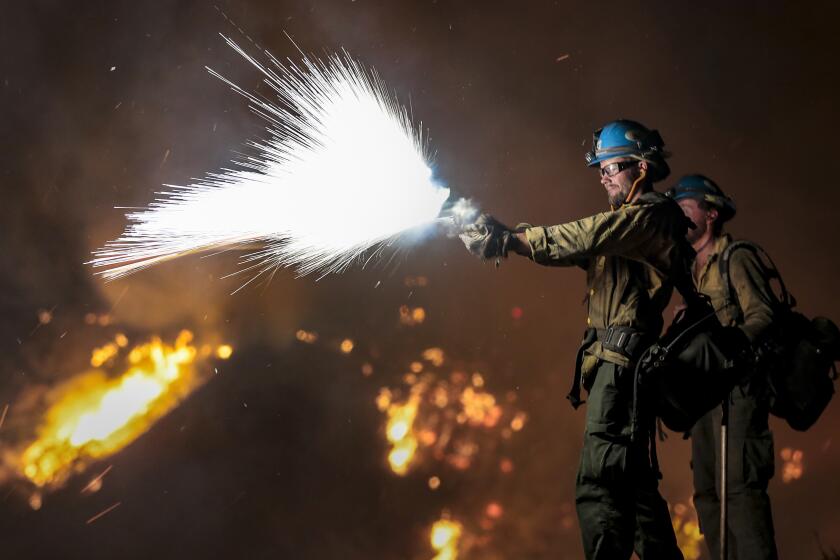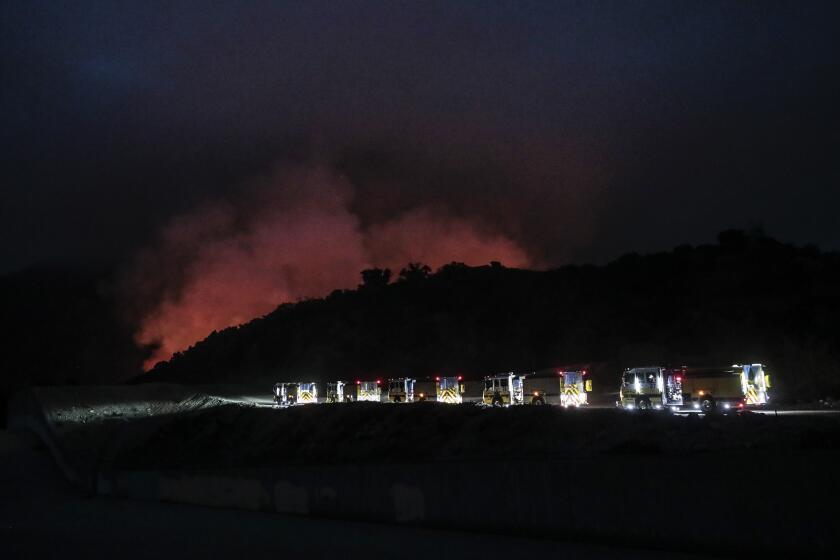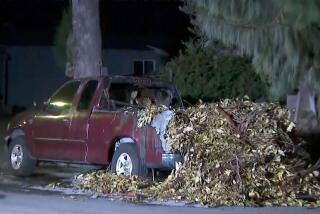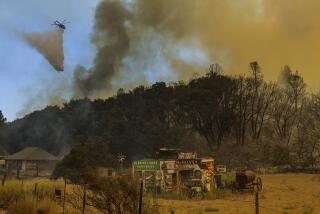Bobcat fire is just 1.6 miles from Mt. Wilson Observatory. Firefighters ready for battle

It was 1 p.m., and flurries of ashes were falling like snow for the fourth consecutive day. David Cendejas looked toward massive clouds of smoke rising off the eastern flank of the Bobcat fire as it marched westward toward the Mt. Wilson Observatory and nearby thickets of broadcast spires stabbing hundreds of feet skyward.
“The fire has moved to within 1.6 miles away from the observatory,” said Cendenjas, 28, superintendent of the complex that houses 18 astronomical wonders including the 100-inch Hooker telescope, which proved the existence of other galaxies flung across the universe. “A bit of good news is that the smoke was so thick Sunday night that it choked the speed of fire’s advance.”
Cendejas and other staffers had spent the morning introducing more than three dozen firefighters to the emergency firefighting systems and backup electric generators strategically located across the property perched on a 5,710-foot mountain shaded by pines and oak forests.
Fears of a significant spread of the Bobcat fire dissipated as Santa Ana winds failed to materialize, but foothill communities remain on high alert.
They included a water tank connected to a high-pressure pump built in 1970, last used when the observatory was rescued from snarling flames of the Station fire after a fight that lasted five days and four nights.
Now, as menacing columns of smoke churned turned the sky orange and gray, firefighters in 12 fire engines were girding for the arrival of the flames, which would trigger a screeching blare from large horns on the observatory’s gleaming white dome.
By 1:45, a sense of urgency swept across the grounds.
“We’re not going anywhere,” Los Angeles County Fire Department Capt. Keith Stires said. “We are committed here.”
Firefighters began quietly and efficiently unspooling fire hoses. Battalion chiefs were studying maps.
The Mill Creek Hotshots, from San Bernardino, arrived and took up positions near broadcast towers owned by media companies and federal agencies of every stripe.
“All nonessentials have to leave immediately,” Dendejas told a visitor.
Record heat. Raging fires. What are the solutions?
Get Boiling Point, our newsletter about climate change, the environment and building a more sustainable California.
You may occasionally receive promotional content from the Los Angeles Times.
The Bobcat fire has burned more than 36,000 acres and is only 6% contained.
As night fell, officials said they were still concerned about its spread, especially around Mt. Wilson.
An L.A. County Public Works assistant dam operator at Cogswell Dam, a remote county flood control operation that looms over an 8-mile-long stretch of the San Gabriel River’s west fork, discovered the Bobcat fire at 12:21 p.m. on Sept. 6.
The operation controls the flow of the stream, which provides some of the best fly fishing in Southern California and helps recharge the metropolitan aquifer in the flatlands below.
“The fire spread rapidly,” said Kerjon Lee, a spokesman for the county agency. “He called 911. Public works operators have evacuated the area.”
The fire surrounded the dam, Lee said, “but no structures there have been damaged, and no injuries are reported.”
Firefighters are taking water from Cogswell and San Gabriel Reservoirs in the San Gabriel Mountains above Azusa.
An estimate for containment of California’s Bobcat fire, which ignited Sept. 6 and has burned over 36,000 acres, has been pushed back to Oct. 30.
On Monday afternoon, he said, flames were approaching Santa Anita Dam, less than a mile above Arcadia.
“We’re approaching winter storm season,” Lee said, “and that infrastructure is critical to protect downstream communities from potential flooding.”
More to Read
Start your day right
Sign up for Essential California for news, features and recommendations from the L.A. Times and beyond in your inbox six days a week.
You may occasionally receive promotional content from the Los Angeles Times.








